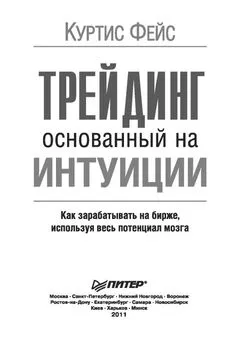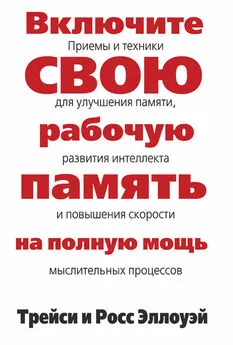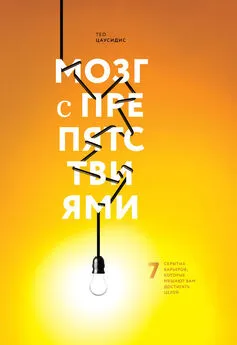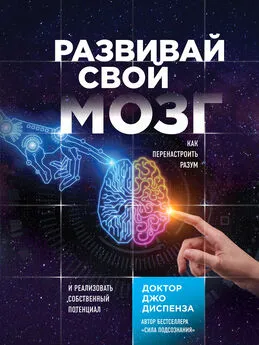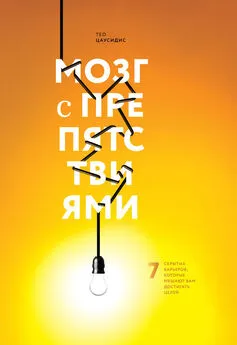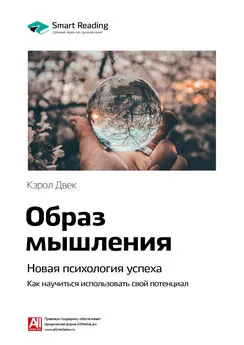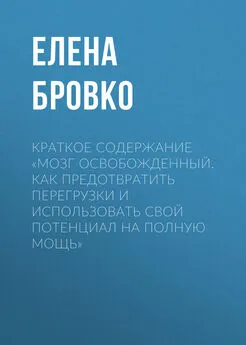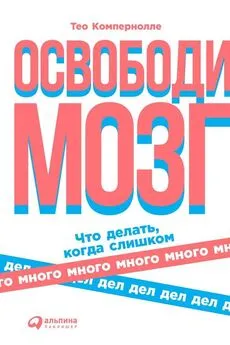Тео Компернолле - Мозг освобожденный. Как предотвратить перегрузки и использовать свой потенциал на полную мощь
- Название:Мозг освобожденный. Как предотвратить перегрузки и использовать свой потенциал на полную мощь
- Автор:
- Жанр:
- Издательство:Array Литагент «Альпина»
- Год:2015
- Город:Москва
- ISBN:978-5-9614-3976-1
- Рейтинг:
- Избранное:Добавить в избранное
-
Отзывы:
-
Ваша оценка:
Тео Компернолле - Мозг освобожденный. Как предотвратить перегрузки и использовать свой потенциал на полную мощь краткое содержание
Мозг освобожденный. Как предотвратить перегрузки и использовать свой потенциал на полную мощь - читать онлайн бесплатно полную версию (весь текст целиком)
Интервал:
Закладка:
(abstract only) Hands Free Texting While Driving – Is It Safer than Conventional Texting While Driving? Young, Kaysha.
409
Control of Attention Shifts between Vision and Audition in Human Cortex. Sarah Shomstein and Steven Yantis. The Journal of Neuroscience, 24 Nov 2004, 24(47): 10702–10706.
410
The crosstalk hypothesis: Why language interferes with driving. Bergen, Benjamin; Medeiros-Ward, Nathan; Wheeler, Kathryn; Drews, Frank; Strayer, David. Journal of Experimental Psychology: General, Vol. 142(1), Feb 2013, pp. 119–130.
How Speech Modifies Visual Attention. Spence, I., Jia, A., Feng, J., Elserafi, J., & Zhao, Y. (2013). Applied Cognitive Psychology, 27(5), pp. 633–643.
Effect of cellular telephone conversations and other potential interference on reaction time in a braking response. William Consiglio, Peter Driscoll, Matthew Witte, William P. Ber.Accident Analysis and Prevention 35 (2003), pp. 495–500.
411
Distracted Driving Among. Newly Licensed Teen. Drivers. Март 2012. AAA Foundation/UNC Highway Safety Research Center. Arthur H. Goodwin. Robert D. Foss. Stephanie S. Harrell Natalie P. O’Brien. http://www.distraction.gov/download/DistractedDrivingAmongNewlyLicensedTeenDrivers.pdf
412
Последний обзор исследований, осуществленных Национальной ассоциацией губернаторов по безопасности дорожного движения, смотрите по адресу: http://www.ghsa.org/html/publications/pdf/sfdist11.pdf
413
www.nhtsa.gov/staticfiles/nti/pdf/811555.pdf
414
The 100-Car Naturalistic Driving Study, Phase II ralistic DrivingmongNewl Field Experiment. Dingus, T. A., ao. 2006. National Highway Traffic Safety Admin. (NHTSA). http://www.distraction.gov/research/PDF-Files/The-100-Car-Naturalistic-Driving-Study.pdf.
415
The 100-Car Naturalistic Driving Study, Phase II uralistic Drivingch/PDF– Field Experiment. Dingus, T. A., ao. 2006. National Highway Traffic Safety Admin. (NHTSA). http://www.distraction.gov/research/PDF-Files/The-100-Car-Naturalistic-Driving-Study.pdf
416
Cognitive Distraction While Multitasking in the Automobile. David L. Strayer, Jason M. Watson, and Frank A. Drews. Psychology of Learning and Motivation, Volume 54, 2011, pp. 29–58. http://psych.utah.edu/lab/appliedcognition/publications/distractionmultitasking.pdf
Measuring Cognitive Distraction in the Automobile. Strayer, David L. Cooper, Joel M. for AAA Foundation for Traffic Safety. 2013. https://www.aaafoundation.org/sites/default/files/Measuring-CognitiveDistractions.pdf
http://trid.trb.org/view.aspx?id=1252566
417
Cell Phones and Driving: Review of Research. Anne T. McCartt, Laurie A. Hellinga, and Keli a. Braitman. Traffic Injury Prevention, 2006, 7: pp. 89–106. http://www.childinjurylaws.com/pdf/Cell%20Phones%20and%20Driving-%20Review%20of%20Research.pdf
Effect of cellular telephone conversations and other potential interference on reaction time in a braking response. William Consiglio, Peter Driscoll, Matthew Witte, William P. Ber. Accident Analysis and Prevention 35 (2003), pp. 495–500.
How Speech Modifies Visual Attention. Spence, I., Jia, A., Feng, J., Elserafi, J., & Zhao, Y. (2013). Applied Cognitive Psychology, 27(5), pp. 633–643.
Speech-Based Interaction with In-Vehicle Computers: The Effect of Speech-Based E-Mail on Drivers’ Attention to the Roadway John D. Lee Human Factors: The Journal of the Human Factors and Ergonomics Society, Winter 2001, vol. 43, no. 4, pp. 631–640.
418
Engrossed in conversation: The impact of cell phones on simulated driving performance. Kristen E. Beede, Steven J. Kass.Volume 38, Issue 2, March 2006, pp. 415–421.
419
An on-road assessment of cognitive distraction: Impacts on drivers’ visual behavior and braking performance. J. Harbluk et al. Accident Analysis and Prevention. Volume 39, 2007, p. 372.
Examining the impact of cell phone conversations on driving using metaanalytic techniques. W. Horrey et al. Human Factors. Volume 48, Spring 2006, р. 196.
Gorillas in our midst: sustained inattentional blindness for dynamic events. D. Simons and C. Chabris. Perception. Volume 28, 1999, р. 1059.
420
(расстояние × sin10°)/sin85°.
421
Чтобы найти интересные зрительные иллюзии, просто наберите в поисковике Google или Bing фразу «перцептивное постоянство» ( subjective constancy ).
422
David Strayer quoted in: Impactful Distraction. Talking while driving poses dangers that people seem unable to see. Nathan Seppa 12:15PM, 9 Aug 2013.
423
A few examples:
http://www.youtube.com/watch?v=dCHdZxO4_tQ; http://www.youtube.com/watch?v=PRPkRFAQBYU; http://www.youtube.com/watch?v=HhbBXFw6dm4; http://www.youtube.com/watch?v=TY_sdJKbIbo; http://www.youtube.com/watch?v=umRXAkZ8X00
424
Cell Phone Use While Driving and Attributable Crash Risk. Annette Maciej, Manuela Nitsch, Mark Vollrath. Transportation Research Part F: Traffic Psychology and Behaviour. Volume 14, Issue 6, Nov 2011, pp. 512–524.
Shut up i’m driving! is talking to an inconsiderate passenger the same as talking on a mobile telephone? Natasha Merat, A. Hamish Jamson, PROCEEDINGS of the Third International Driving Symposium on Human Factors in Driver Assessment, Training and Vehicle Design. 2005. http://drivingassessment.uiowa.edu/DA2005/PDF/63_Meratformat.pdf
Cell Phones and Driving: Review of Research. Anne T. McCartt, Laurie A. Hellinga, and Keli a. Braitman. Traffic Injury Prevention, 2006, 7: pp. 89–106.
http://www.childinjurylaws.com/pdf/Cell%20Phones%20and%20Driving-%20Review%20of%20Research.pdf
425
Driver Reaction Time to Tactile and Auditory Rear-End Collision Warnings WhileTalking on a Cell Phone. Rayka Mohebbi, Rob Gray and Hong Z. Tan, 2009, 51: p. 102.
Human Factors: The Journal of the Human Factors and Ergonomics Society.
426
Passenger and cell phone conversations in simulated driving. Drews, F.A., Pasuppathi, M. and Strayer D.L., Journal of Experimental Psychology: Applied 14 (2008), pp. 392–400.
The contribution of passengers versus mobile phone use to motor vehicle crashes resulting in hospital attendance by the driver. Suzanne P McEvoy, Mark R. Stevenson, Mark Woodward. Accident Analysis & Prevention. Volume 39, Issue 6, Nov 2007, pp. 1170–1176.
Carrying Passengers as a Risk Factor for Crashes Fatal to 16– and 17-Year-Old Drivers. Li-Hui Chen, Susan P. Baker, Elisa R. Braver, Guohua Li. JAMA. 2000; 283(12): pp. 1578–1582.
427
Cognitive Distraction While Multitasking in the Automobile. Strayer, Watson & Drews, Chapter two – The Psychology of Learning and Motivation: Advances in Research and Theory. Edited by Brian H. Ross. 2011. Volume 54, pp. 1–305.
Crundall, M. Bains, P. Chapman, G.Underwood. Regulating conversation during driving: a problem for mobile phones. Transport Res. F, 8 (2005), pp. 197–211.
Passenger and cell phone conversations in simulated driving. Drews, Frank A.; Pasupathi, Monisha; Strayer, David L. Journal of Experimental Psychology: Applied, Vol. 14(4)
Regulating conversation during driving: a problem for mobile telephones? Crundall, D., Bains, M., Chapman, P., Underwood, G., 2005.Transp. Res., Part F 8, pp. 197–211 (research during real driving).
Distracted driving in elderly and middleaged drivers. Kelsey R. Thompson et al. Accident Analysis & Prevention. Volume 45, March 2012, pp. 711–717.
Effects of cellular telephones on driving behaviour and crash risk: Results of meta-analysis. J.K. Caird, CT Scialfafivingged Regulating conver http://www.psych.ucalgary.ca/pace/PCA-Lab/pdf/Final%20Report%20-%20Cell%20Phones.pdf
428
The Effects Of Acute Sleep Deprivation On Selective Attention. Royan Norton. British Journal Of Psychology. May 1970. Volume 61, Issue 2, pp. 157–161.
429
The Effects Of Early And Late Night Partial Sleep Deprivation On Automatic And Selective Attention: An Erp Study. Zerouali Y., Jemel B., Godbout R. Brain Res. 13 Jan 2010; 1308: pp. 87–99. Doi: 10.1016/J.Brainres.2009.09.090. Epub 2009 Sep 30.
430
Sleep Deprivation Impairs Object-Selective Attention: A View From The Ventral Visual Cortex. Lim J, Tan Jc, Parimal S, Dinges Df, Chee Mw. Plos One. 5 Feb 2010; 5(2): E9087. Doi: 10.1371/Journal. Pone.0009087.
Objective and subjective measures of sleepiness, and their associations with on-road driving events in shift workers. Ftouni, S., Sletten, T. L., Howard, M., Anderson, C., Lenné, M. G., Lockley, S. W., & Rajaratnam, S. M. (2013). Journal of Sleep Research, 22(1), pp. 58–69.
Road accidents caused by sleepy drivers: Update of a Norwegian survey, Ross Owen Phillips, Fridulv Sagberg, Accident Analysis & Prevention, Volume 50, Jan 2013, pp. 138–146.
Objective and subjective measures of sleepiness, and their associations with on road driving events in shift workers. Ftouni, S., Sletten, T. L., Howard, M., Anderson, C., Lenne, M. G., Lockley, S. W., & Rajaratnam, S. M. (2013). Journal of Sleep Research, 22(1), pp. 58–69.
Now you hear me, now you don’t: eyelid closures as an indicator of auditory task disengagement. Ong, J. L., Asplund, C. L., Chia, T. T. Y., & Chee, M. W. L. (2013). Sleep, 36(12), 1867.
Driver performance in the moments surrounding a microsleep, Linda Ng. Boyle, Jon Tippin, Amit Paul, Matthew Rizzo, Transportation Research Part F: Traffic Psychology and Behaviour, Volume 11, Issue 2, March 2008, pp. 126–136.
Driver performance in the moments surrounding a microsleep, Linda Ng. Boyle, Jon Tippin, Amit Paul, Matthew Rizzo, Transportation Research Part F: Traffic Psychology and Behaviour, Volume 11, Issue 2, March 2008, pp. 126–136.
Having to stop driving at night because of dangerous sleepinessat night be physiology and behaviour. Åkerstedt, T., Hallvig, D., Anund, A., Fors, C., Schwarz, J., & Kecklund, G. (2013). Journal of sleep research.
Driver sleepiness. J. A. Horne*, L. A. Reyner Journal of Sleep Research. Dec 1995. Volume 4, Issue Supplement s2, pp. 23–29.
Specific sleepiness symptoms are indicators of performance impairment during sleep deprivation, Mark E. Howard, Melinda L. Jackson, David Berlowitz, Fergal OL. Jackson, David Berlow Justine Westlake, Vanessa Wilkinson, Rob J. Pierce, Accident Analysis & Prevention, Volume 62, Jan 2014, pp. 1–8.
Half of drivers ignore basic advice to prevent deadly tiredness at the wheel. 25 July 2013. http://www.directline.com/about_us/news_25072013.htm
431
The effect of caffeine on working memory load-related brain activation in middle-aged males, Elissa B. Klaassen, Renate H.M. de Groot, Elisabeth. T. Evers, Jan Snel, Enno C.I. Veerman, Antoon J.M. Ligtenberg, Jelle Jolles, Dick J. Veltman, Neuropharmacology, Volume 64, Jan 2013, pp. 160–167.
Effects of caffeine on human behavior, A. Smith, Food and Chemical Toxicology, Volume 40, Issue 9, Sep 2002, pp. 1243–1255.
Influence of caffeine on physiological and cognitive functions of humans. Shapkin, S. A. (2002). Human Physiology, 28(1), pp. 128–133.
Читать дальшеИнтервал:
Закладка:

